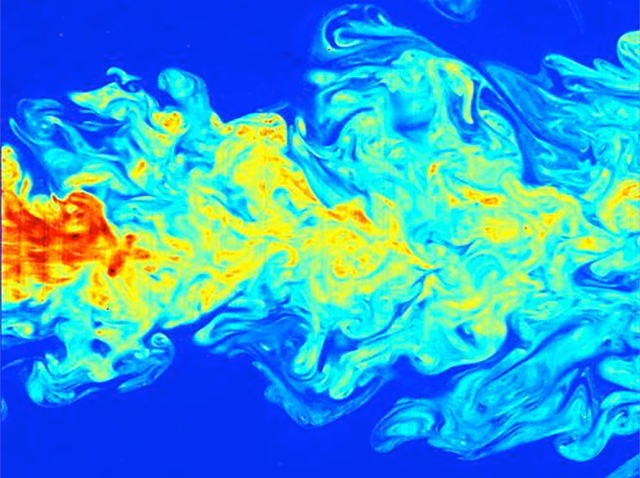A Fluid New Path in Grand Math Challenge

In Dr. Seuss’s book “The Cat in the Hat Comes Back,” the Cat makes a stain he can’t clean up, so he calls upon the help of Little Cat A, a smaller, perfect replica of the Cat who has been hiding under the Cat’s hat. Little Cat A then calls forth Little Cat B, an even smaller replica hidden under Little Cat A’s hat. Each cat in turn lifts his hat to reveal a smaller cat who possesses all the energy and good cheer of the original Cat, just crammed into a tinier package. Finally, Little Cat Z, who is too small to see, unleashes a VOOM like a giant explosion of energy, and the stain disappears.
A similar process lies at the heart of a speculative new approach to a problem that has bedeviled mathematicians for more than 150 years: understanding the solutions to the Navier-Stokes equations of fluid flow, which physicists use to model ocean currents, weather patterns and other phenomena. These equations are so complex that in most cases, no one knows whether the solution will be smooth and well-behaved, without any sudden shifts of direction or explosions of energy, for instance. And computer models of the solutions run aground, unable to accurately capture the behavior of small eddies.
Now, in a paper posted online on February 3, Terence Tao of the University of California, Los Angeles, a winner of the Fields Medal, mathematics’ highest honor, offers a possible way to break the impasse. He has shown that in an alternative abstract universe closely related to the one described by the Navier-Stokes equations, it is possible for a body of fluid to form a sort of computer, which can build a self-replicating fluid robot that, like the Cat in the Hat, keeps transferring its energy to smaller and smaller copies of itself until the fluid “blows up.” As strange as it sounds, it may be possible, Tao proposes, to construct the same kind of self-replicator in the case of the true Navier-Stokes equations. If so, this fluid computer would settle a question that the Clay Mathematics Institute in 2000 dubbed one of the seven most important problems in modern mathematics, and for which it offered a million-dollar prize. Is a fluid governed by the Navier-Stokes equations guaranteed to flow smoothly for all time, the problem asks, or could it eventually hit a “blowup” in which something physically impossible happens, such as a non-zero amount of energy concentrated into a single point in space?
Tao’s new program for tackling Navier-Stokes has changed his thinking about the problem.
Tao’s proposal is “a tall order,” said Charles Fefferman of Princeton University. “But it’s a very interesting way of thinking about the long-term future of the problem.”
The real ocean doesn’t spontaneously blow up, of course, and perhaps for that reason, most mathematicians have concentrated their energy on trying to prove that the solutions to the Navier-Stokes equations remain smooth and well-behaved forever, a property called global regularity. Purported proofs of global regularity surface every few months, but so far each one has had a fatal flaw. (The most recent attempt to garner serious attention, by Mukhtarbay Otelbaev of the Eurasian National University in Astana, Kazakhstan, is still under review, but mathematicians have already uncovered significant problems with the proof, which Otelbaev is trying to solve.)
“Everyone in the research community would agree that the tools we have at the moment are not sufficient to prove global regularity,” said Susan Friedlander, of the University of Southern California in Los Angeles.
Tao originally set out with a fairly modest goal: simply to make rigorous the intuition that the existing tools are not good enough. Many would-be proofs of global regularity have tried to exploit a principle of conservation of energy, and Tao set out to show that this principle is not sufficient to establish global regularity. He constructed a counterexample, a sort of toy fluid-flow universe whose governing equations have many commonalities with the Navier-Stokes equations, including conservation of energy, but whose solutions can blow up.
A decade earlier, Nets Katz, now of the California Institute of Technology in Pasadena, and Natasa Pavlovic, now of the University of Texas, Austin, had established blowup for a toy version of a simpler fluid flow model by showing how to transfer a given amount of energy into smaller and smaller size scales until, after a finite amount of time, all the energy would be packed into a single point, and the fluid would blow up. But Katz and Pavlovic’s process distributed the energy across many different size scales at the same time, as if the Cat had lifted his hat to reveal not Little Cat A, but weak versions of many of the smaller cats. When Katz and Pavlovic tried to extend their process to a toy version of the Navier-Stokes equations, the fluid’s viscosity snuffed out this thinned-out energy and no blowup occurred.
To make the transfer of energy more controllable, Tao tried to devise a system that would incorporate a delay at each step — a sort of timer that would push the energy cleanly from one size scale to the next at just the right moment. He found himself thinking like an electrical engineer in terms of circuits, capacitors, resistors and fuses, until he realized what he was really doing: trying to create a computer out of fluid.
Tao started designing fluid “logic gates,” the basic building blocks of all computers, which transform information or energy according to particular rules. One of his gates pumped energy from one region of a fluid to another; a second gate rapidly exchanged energy between two regions if a third region passed a certain energy threshold. Tao realized that he could string together five such gates to create a self-replicating fluid machine. He then designed a particular toy universe in which these five gates were all achievable.
While Tao’s construction applies only to this toy universe, “in principle, there’s nothing stopping the actual Navier-Stokes equations from doing this,” he said. “There’s no immediate mathematical objection to this working — just a huge practical objection.”
Fluid-based computers are already in use in some specialized settings such as in aircrafts, but these computers use pipes and valves made out of solid materials. Tao’s computer would have to be made entirely out of water.
“It’s a very fanciful idea, and I don’t expect this program to come to fruition any time in the next five years,” Tao said. Nevertheless, he said, it may be possible to harness fluid effects such as miniature vortex sheets to create water barriers that could serve as pipes.
The new proposal, however intriguing, is just speculation, cautioned Peter Constantin of Princeton University. “This is mathematics,” he said. “What’s proved is proved.”
Tao’s ideas certainly aren’t standard, Friedlander said. “But results about global regularity, whether positive or negative, will almost certainly require something that is nonstandard.” Tao’s ideas are quite likely to lead to some interesting mathematics, she said, whether or not they answer the Navier-Stokes question.
Meanwhile, Tao’s new program for tackling Navier-Stokes has changed his thinking about the problem. Previously, he had viewed both sides of the problem — proving global regularity or establishing that solutions can blow up — as equally remote goals (though in the end, only one can be true). Now he believes that it should be possible to concoct special scenarios in which a solution to the Navier-Stokes equations blows up. (This wouldn’t mean that the real ocean could blow up — instead, it would suggest that in these rare cases, the Navier-Stokes equations don’t fully capture the ocean’s physics.) “My mindset has certainly changed,” he said.
A central insight of computer science is that, whenever a physical phenomenon is complex enough, it should be possible to use it to build a universal computer — one capable of doing anything computers can do, including building self-replicating machines.
“Can you make fancy patterns of water that actually have some computation power?” Tao asked. “I’m betting that fluids are complex enough to do this.”
This article was reprinted on ScientificAmerican.com.



